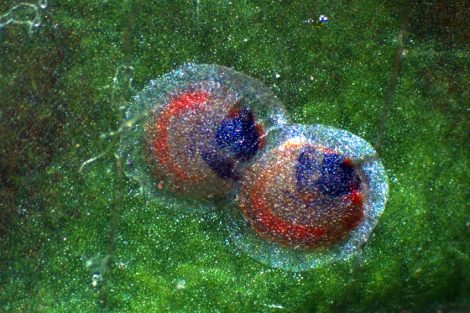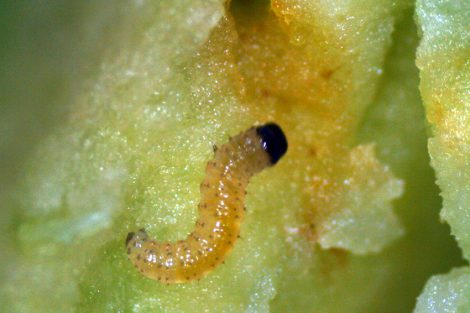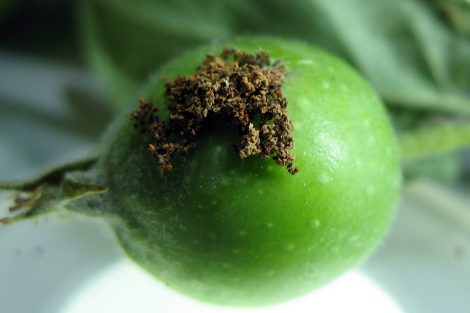In this Issue
- Codling moth: first generation spray dates provided for most locations
- Peach powdery mildew: if a problem in the past, treat at shuck-split stage and repeat
- Green peach aphid: damage is visible now
- Raspberry horntail: treat canes in late May to early June
APPLE, PEAR
Codling Moth
View a pdf of the spray timing table. Please read the instructions at the top of the page, for how to understand the table.
Codling moth is a pest that needs to be treated all season long for clean fruit. Moths lay eggs on fruit, and the larvae tunnel in and feed on the seeds of the fruit for about 5 weeks. They then pupate into a moth to form the second generation of larvae in early summer.
The codling moth treatment timing is coming up in mid- to late May for many areas of northern Utah. There are about three colder locations that we do not have timing dates yet. Not all Utah locations are provided on the table. To remedy this, either select your closest city on the table, or, go to the Utah TRAPs website, select your city on the map, and select “Codling Moth-Fixed Biofix” from the Pest drop-down menu on the right.
The pdf table of dates provides two options for managing the first generation.
- “Option A” is the traditional method, where the first insecticide coincides with egg hatch. So the spray application would target young larvae, which may occur on fruitlets or on leaves.
- “Option B” targets the eggs themselves with horticultural oil. Good coverage of a 1% application will smother all eggs laid up to that point, providing a “clean slate.” Then, an insecticide application is made later, targeting the larvae that will begin hatching from the new set of eggs laid after the oil application. This option can save at least one insecticide spray, and also, the insecticide is applied at the start of greatest egg hatch.
- For either option, it is recommended to repeat the application to protect fruit at least through the “period of greatest egg hatch” (dates shown on the table).
Whether you are growing organic or conventional, the only non-spray option for clean fruit is to bag them (click here and here for more info on bagging fruit) and that would be done when you thin the fruit after bloom, or when they are about 0.5″ diameter.
How Often to Treat (Residential):
For strategies on how often to spray for codling moth, it will depend on whether you are using organic or non-organic options, AND how heavily your apples or pears have been infested with codling moth in the past.
Conventional production options
- High fruit damage in past years:
- Apply the first application for either Option A (insecticide) or Option B (oil).
- For Option A, repeat the insecticide spray 14 days later, for a total of 2 applications in the first generation.
- For Option B, apply the insecticide spray at the listed date once.
- When the “start date” for the 2nd generation is provided (in a future advisory), spray every 10-18 days until Sept. 15.
- Pick a different product to use for each generation.
- Low fruit damage in past years:
- Apply the first application for either Option A (insecticide) or Option B (oil).
- For Option A, do not spray again.
- For Option B, apply insecticide at the listed date.
- Wait until the “start date” for the 2nd generation is provided, and spray on that date, and repeat 14 days later, for a total of 2 sprays.
- Do the same for the 3rd generation.
- Pick a different product to use for each generation.
Organic production options (other than bagging)
- High fruit damage in past years:
- Apply the first application for either Option A (insecticide) or Option B (oil).
- For Option A, repeat twice, spaced 7-10 apart, for a total of 3 applications in the first generation.
- For Option B, apply insecticide at the listed date and re-apply 7-10 days later.
- When the “start date” for the 2nd generation is provided, spray every 7-10 days until Sept. 15.
- Pick a different product to use for each generation.
- Low fruit damage in past years:
- Apply the first application for either Option A (insecticide) or Option B (oil).
- When the “start date” for the 2nd generation is provided, spray every 10-14 days until Sept. 15.
- Pick a different product to use for each generation.
Treatment Options
Spray options for commercial growers.
The table below provides some options for backyard trees. It is important to know how long your spray application will last. For the product you are using, check the “active ingredients” on the front label of your product (in small print on the lower right or left of the label). Sometimes there are several ingredients, sometimes, just one. Some materials last longer than others, and the time between sprays is not always listed on the label.
| Product Name | Efficacy | Residual Length (days) | Comments |
|---|---|---|---|
| CONVENTIONAL | |||
| Spectracide Triazicide (gamma-cyhalothrin) | Good to Excellent | 14-17 | wait 21 days to harvest |
| Monterey Bug Buster 11 (esfenvalerate) | Good to Excellent | 14-17 | wait 21 days to harvest |
| Bonide Fruit Tree & Plant Guard (lambda-cyhalothrin) | Good to Excellent | 14-17 | wait 21 days to harvest |
| Bonide Malathion; Hi Yield Malathion | Good | 5-7 | max 2 applications; some products are pears only |
| GardenTech Sevin (zeta-cypermethrin) | Good to Excellent | 14-17 | wait 14 days to harvest |
| ORGANIC | |||
| AzaSol, EcoGarden (azadirachtin) | Good | 7-10 | purchase online |
| Cyd-X (codling moth virus) | Good (if populations are low) | 7 | works best when used at beginning of generation; expensive and purchase online |
| oil such as All Seasons Oil, EcoSmart, Neem oil | Good on eggs only | 3 | recommended for first application of the generation only |
| Ortho Fruit Spray; Fertilome Fruit Tree Spray; Safer End All; Bonide Orchard Spray (all contain pyrethrin) | Good | 3-5 | |
| Monterey / Fertilome Spinosad; Captain Jack's Deadbug Brew; Natural Guard (all contain spinosad) | Good | 10 | max 6 applications per season; if applying to peach or cherry, can re-apply after 7 days |
PEACH/NECTARINE, APRICOT
Peach Powdery Mildew
Apply fungicide at shuck split stage (which will also treat coryneum blight)
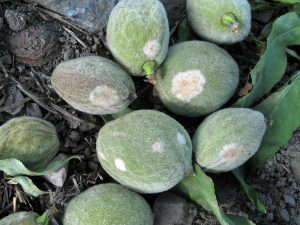
There are two fungal species that cause powdery mildew (PM) on peach. One is specific to peach (Sphaerotheca pannosa), affecting the foliage and fruit, and the other is apple powdery mildew (Podosphaera leucotricha), that only affects the fruit.
Peach PM overwinters on roses and sometimes on peach buds and bark. In spring, when nights are cool and moist, and days are warm, spores infect foliage (rarely) and peach fruitlets. On fruit, new lesions look like fuzzy, bright white spots. Fruit infections can occur all spring until the pit hardening stage. (The only way to tell pit-hardening is to slice peaches.) Infections on leaves are typically only seen later in the season.
Apple PM on peach is referred to as “rusty spot.” The fungus overwinters on apples only, and fruit of peach trees grown near apple trees with PM may be affected. On peach fruit, new lesions look pale whitish at first, and within a few days, the skin under the infection takes on a rusty-orange streaking.
Infections of either disease won’t be noticeable on fruit until 2 to 4 weeks after bloom. At that time, monitor 25 fruits on several trees for the presence of round, whitish, powdery spots on the fruit surface. A total of 10 to 20 fruit infections and greater than 20 fruit infections per tree represents moderate and high risk, respectively.
Susceptible varieties include Redskin, Rio Oso Gem, Elegant Lady, Fairtime, Fay Elberta, and Summerset.
Peach powdery mildew can be prevented with a shuck-split (see the May 5 advisory for a picture under “coryneum blight”) or shuck-fall fungicide application.
Treatment
Find options for commercial growers by clicking here.
For residential trees, note that fruit that was infected is still edible to eat. If aesthetics is a concern, chlorothalonil or sulfur (organic) can be used (and will also help manage coryneum blight) at the shuck split stage. If a fungicide is needed after shuck split, use sulfur or Spectracide Immunox.
Continue fungicide sprays on susceptible varieties at 10 to 14-day intervals until the pit hardening stage is reached.
Green Peach Aphid
These could be ignored
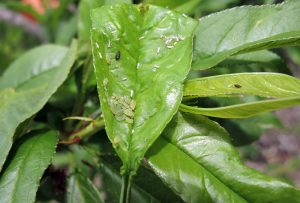
Green peach aphid is a very common pest of peach foliage early in the season. In fact, we have received many calls about high populations. Typically, an oil application plus insecticide applied at budbreak would kill the eggs, but some may survive.
They cause the leaves to curl as they feed, which makes it difficult for an insecticide – whether conventional or organic – to reach the aphids. Some factors to consider when determining whether or not to spray include the following.
- The aphids are actually on the peach trees for just a few more weeks, likely into mid-June or so. Then they leave the tree and migrate to other crops.
- The tree will put out another flush of foliage that will be healthy and not covered by the aphids.
- The aphids are providing food for beneficial predators.
- Because the leaves are so curled, it is hard to get a pesticide spray into the leaves to treat the aphids.
- Most trees can tolerate the damage.
Treatment
- Commercial growers can use Admire Pro, or a generic.
- If necessary, residential growers can use insecticidal soap, but the soap must come into contact with the aphids, as they are tucked tightly within the leaf curls.
SMALL FRUITS
Raspberry Horntail
If raspberry horntail has been a problem, treat for adults in late May to early June
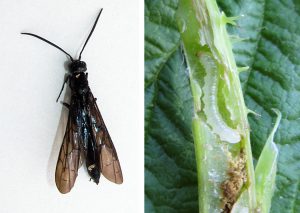
Raspberry horntail is a sawfly that lays eggs in canes. The eggs hatch into larvae that then feed inside the upper canes, causing the tops to wilt and die. Adult horntails will soon begin emerging from canes that were infested last year, towards the end of May.
If raspberry horntail is a problem in your area, an insecticide application to prevent egg-laying should go on May 22 – 28 for warmer areas along the Wasatch Front and June 1 – 5 for cooler areas.
Treatment
An insecticide would target the adults since they lay their eggs inside the canes.
Synthetic pyrethroids (or the organic, pyrethrin) and Sevin are effective. Spinosad is another option, but unproven. A second application should be applied 10-14 days later, depending on product residual and when bloom time is projected to begin. Avoid treating during bloom.

